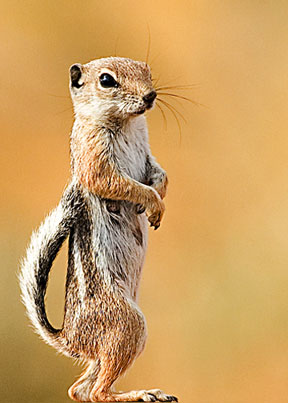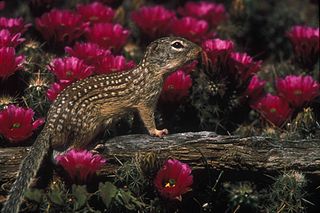
Antelope squirrels or antelope ground squirrels of the genus Ammospermophilus are sciurids found in the desert and dry scrub areas of the southwestern United States and northern Mexico. They are a type of ground squirrel and are able to resist hyperthermia and can survive body temperatures over 40 °C (104 °F).

The California ground squirrel, also known as the Beechey ground squirrel, is a common and easily observed ground squirrel of the western United States and the Baja California Peninsula; it is common in Oregon and California and its range has relatively recently extended into Washington and northwestern Nevada. Formerly placed in Spermophilus, as Spermophilus beecheyi, it was reclassified in Otospermophilus in 2009, as it became clear that Spermophilus as previously defined was not a natural (monophyletic) group. A full species account was published for this species in 2016.

Franklin's ground squirrel is a species of squirrel native to North America, and the only member of the genus Poliocitellus. Due to the destruction of prairie, the populations of Franklin's ground squirrel have dwindled, approaching levels of concern. Its decline in the eastern portion of its range is mostly attributed to habitat fragmentation.

The golden-mantled ground squirrel is a ground squirrel native to western North America. It is distributed in the Rocky Mountains of British Columbia and Alberta, and through much of the western United States.

The northern Idaho ground squirrel is a species of the largest genus of ground squirrels. This species and the Southern Idaho ground squirrel were previously considered conspecific, together called the Idaho ground squirrel.

The hoary marmot is a species of marmot that inhabits the mountains of northwest North America. Hoary marmots live near the tree line on slopes with grasses and forbs to eat and rocky areas for cover.

The yellow-bellied marmot, also known as the rock chuck, is a large, stout-bodied ground squirrel in the marmot genus. It is one of fourteen species of marmots, and is native to mountainous and semi-arid regions of southwestern Canada and western United States, including the Rocky Mountains, Sierra Nevada, and the Great Basin, often living above 2,000 metres. The fur is mainly brown, with a dark bushy tail, yellow chest and white patch between the eyes, and they weigh up to approximately 5 kilograms. They live in burrows in colonies of up to twenty individuals with a single dominant male. They are diurnal and feed on plant material, insects, and bird eggs. They hibernate for approximately eight months starting in September and lasting through the winter.

The steppe polecat, also known as the white or masked polecat, is a species of mustelid native to Central and Eastern Europe and Central and East Asia.It is listed as Least Concern on the IUCN Red List because of its wide distribution, occurrence in a number of protected areas, and tolerance to some degree of habitat modification. It is generally of a very light yellowish colour, with dark limbs and a dark mask across the face. Compared to its relative, the European polecat, the steppe polecat is larger in size and has a more powerfully built skull.

The Mohave ground squirrel is a species of ground squirrel found only in the Mojave Desert in California. The squirrel was first described in 1886 by Frank Stephens of San Diego. It is listed as a threatened species under the California Endangered Species Act, but not under the federal Endangered Species Act. The IUCN lists this species as near threatened.

The Arctic ground squirrel is a species of ground squirrel native to the Arctic and Subarctic of North America and Asia. People in Alaska, particularly around the Aleutians, refer to them as "parka" squirrels, most likely because their pelt is good for the ruff on parkas and for clothing.

Belding's ground squirrel, also called pot gut, sage rat or picket-pin, is a squirrel that lives on mountains in the western United States. In California, it often is found at 6,500 to 11,800 feet (2,000–3,600 m) in meadows between Lake Tahoe and Kings Canyon. This species is not of conservation concern, and its range includes some protected areas.

The Cape ground squirrel or South African ground squirrel is found in most of the drier parts of southern Africa from South Africa, through to Botswana, and into Namibia, including Etosha National Park.

The round-tailed ground squirrel, known as "Ardillón cola redonda" in Spanish, live in the desert of the Southwestern United States and Northwestern Mexico. They are called "ground squirrels" because they burrow in loose soil, often under mesquite trees and creosote bushes.

The Columbian ground squirrel is a species of rodent common in certain regions of Canada and the northwestern United States. It is the second largest member of the genus Urocitellus, which is part of the tribe Marmotini, along with marmots, chipmunks, prairie dogs, and other holarctic ground squirrels. They are stout, with short dense fur, which is characteristically tawny across the bridge of the nose. Social encounters sometimes are initiated with kissing behavior and the most common activity above ground is standing at attention. Residing in mountainous terrain and high plains in northern latitudes, they hibernate for 8 to 9 months of the year in burrows, which may be used for many years. They are emaciated when emerging in the spring. The Columbian ground squirrel came to the attention of the scientific community through writings produced by Lewis and Clark, while 21st century molecular genetics has more finely illuminated its ties with other close relatives.

The Mexican ground squirrel is a species of rodent in the family Sciuridae. It is found in Mexico and the United States. One of its closest relatives is the thirteen-lined ground squirrel.

The Perote ground squirrel is a species of rodent in the family Sciuridae. It is endemic to Mexico and is currently at risk of extinction. Perote ground squirrels live within the same area as rock squirrels but they use different microhabitats. In one case it also shares its habitat with the Mexican ground squirrel. Perote ground squirrels have traits similar to those of spotted ground squirrels found in the northern Mexican Plateau; however they are larger, have shorter tails and yellow backs. Its skull is relatively narrow with a large braincase and they have heavy, thick teeth. Perote ground squirrels have two annual cycles, an active phase (March–November) and a hibernation phase (December–February). Some overlap may occur in March and November however.

The little ground squirrel or little souslik, is a species of rodent in the family Sciuridae. It is found from Eastern Europe to Central Asia.

The rock squirrel is a species of rodent in the family Sciuridae. It is native to Mexico and the Southwestern United States, including southern Nevada, Utah, Colorado, Arizona, New Mexico, West Texas, and the panhandle of Oklahoma.

The Asia Minor ground squirrel, also known as Anatolian souslik, Anatolian ground squirrel, is a species of rodent in the family Sciuridae. It is found in Armenia, Iran, and Turkey. The scientific name roughly translates as "seed-lover with yellow underparts".

Pygmy ground squirrels are small ground squirrels in the genus Xerospermophilus, family Sciuridae, containing four species from Mexico and the United States. The members of this genus were formerly placed in the large ground squirrel genus Spermophilus. Since DNA sequencing of the cytochrome b gene showed that Spermophilus was paraphyletic to the prairie dogs and marmots, this group is now separated, along with six other genera. Within the genus, the Mohave ground squirrel and the round-tailed ground squirrel were thought to be close relatives, sometimes a subgenus Xerospermophilus, while the spotted ground squirrel and the Perote ground squirrel were formerly placed in the subgenus Ictidomys.






















